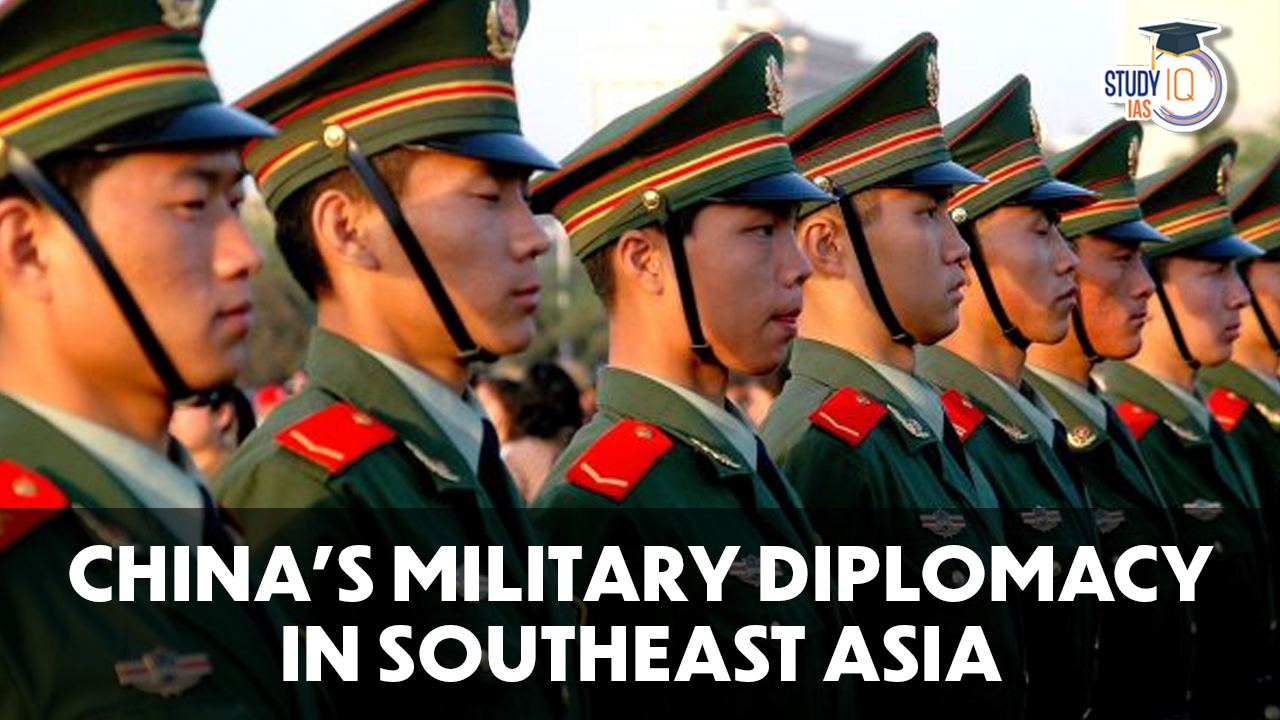Table of Contents
Context: Recently, China is seen expanding its military outreach to Association of Southeast Asian Nations (ASEAN) countries.
- It is a part of China broader reform process initiated by President Xi Jinping in 2015 and form a fundamental element of China’s overall foreign policy.
Highlight of Increasing Military Diplomacy
- Friendship Shield 2023: It is a bilateral military exercise between China and Lao.
- It aim to foster interoperability to effectively counter transnational armed criminal groups based in jungles and mountains.
- Golden Dragon Drills: It is a military exercise between China and Combodia.
- It saw the participation of over 200 troops from the PLA STC’s Army, the Navy, and the Logistical Support Force, who arrived in Cambodia aboard a Type 071 comprehensive landing vehicle, Jinggangshan.
- The exercise entailed joint anti-terrorism and humanitarian aid operations.
- China and Singaporean Navy: Both sides deployed minesweepers (PLA Chibi and RSS Intrepid) and frigates (PLA Yulin and RSS Punggol) for shore and sea operations.
Reasons for Increasing frequency of Chinese military drills with its ASEAN partners
- Global Security Initiative (GSI): China has put excessive emphasis on defence diplomacy under his flagship Global Security Initiative (GSI).
Global Security Initiative (GSI)
- It is a China-led framework aiming to restore stability and security in Asia.
- It was stated that the five major pillars to implement GSI would be:
- Mutual respect
- Openness and inclusion
- Multilateralism
- Mutual benefit
- Holistic approach
Key Principles of GSI:
- Principle of Indivisible Security: With growing threats posed by unilateralism, hegemony and power politics, and increasing deficits in peace, security, trust and governance, mankind is facing more and more intractable problems and security threats.
- Asian Security Model: GSI calls for a “common, comprehensive, cooperative and sustainable” security and building an Asian security model of mutual respect, openness and integration”.
- Opposing Sanctions: This would oppose the use of unilateral sanctions and long-arm jurisdiction, appearing to refer to Western sanctions.
- Tackling New Cold War: Indo-Pacific’ strategy to divide the region and create a ‘new Cold War’, and the use of military alliances to put together an ‘Asian version of North Atlantic Treaty Organization (NATO).
- US Proximity with ASEAN: China’s threat perception of expanding the United States military engagement with countries in the Asia-Pacific region, especially those countries that China has disputes with in the South and East China Seas region.
Infrastructure Push by China in ASEAN Countries
- Indonesia has been proactively applauding Chinese support in the advancement of its vaccine programme and its high-speed rail network.
- Similarly, Vietnam remain neutral due to the success of the Sino-Vietnamese ‘Two Corridors and One Economic Circle’ Belt and Road project.
- Progress of China-Myanmar Economic Corridor and China’s new surveillance military base on Great Coco Islands in Myanmar.

Challenges in Realising China Military Diplomacy
- Proximity of U.S. with Philippines: China shares a disputed maritime border in the Luzon Strait in the South China Sea with Philippines.
- Philippines has decided to provide the U.S. with access to four military bases in addition to the five bases the U.S. already had access to, under the 2014 Enhanced Defence Cooperation Agreement between the two sides.
- These bases are advantageous for the U.S. during an offensive against China, as they help fulfil purposes such as refuel and resupply for warships, intelligence, reconnaissance and surveillance (ISR), and blocking Chinese trade through critical chokepoints in the South China Sea.
- GSI and ASEAN’s cohesiveness: As per ISEAS’s ‘State of Southeast Asia Survey 2023’, on average, 27% of those surveyed in the 10 ASEAN place confidence in the GSI.
- In countries such as Indonesia, Philippines, Vietnam, Thailand and Myanmar, well over 50% surveyed place little to no confidence in it.
- However, in countries such as Cambodia and Brunei, nearly 50% are confident about the Initiative.
Conclusion
- To defend its claims and interests in the region, China is likely to pursue both aggressive military posturing and diplomacy in Southeast Asia.
- China is preparing a new naval base in the Ream region of Cambodia.
- However, despite China’s military and economic inroads in the region, it needs to prove to ASEAN countries sitting on the fence that it has the capability to exercise restraint and act in accordance with the provisions of a Code of Conduct in the South China Sea.
Association of Southeast Asian Nations (ASEAN
- It is a regional organization which was established to promote political and social stability amid rising tensions among the Asia-Pacific’s post-colonial states.
- Established in 1967 with the signing of the ASEAN Declaration (Bangkok Declaration) by its founding fathers.
- Founding Fathers of ASEAN are: Indonesia, Malaysia, Philippines, Singapore and Thailand.
- Current Members: Brunei, Burma (Myanmar), Cambodia, Timor-Leste, Indonesia, Laos, Malaysia, the Philippines, Singapore, Thailand and Vietnam.
- ASEAN Secretariat: Indonesia, Jakarta.
The Treaty of Amity and Cooperation in Southeast Asia (TAC)
- It was established in 1976 and embodies universal principles of peaceful coexistence and friendly cooperation among States in Southeast Asia.
- It is a legally binding code for inter-state relations in the region and beyond.


 Daily Quiz 01 July 2025
Daily Quiz 01 July 2025
 China, Pakistan and Bangladesh Trilatera...
China, Pakistan and Bangladesh Trilatera...
 US Pulls Funding from GAVI-Global Vaccin...
US Pulls Funding from GAVI-Global Vaccin...





















